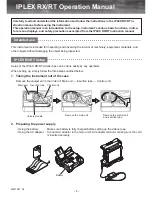
Installing the foreground monitor
The foreground monitor supports all features of the emulator, but imposes on your
target system more than the background monitor. The foreground monitor occupies
a 4-Kbyte block in your target memory space. The emulator provides memory for
this 4-Kbyte block, but the target system cannot use this address range for anything.
The cycles strobes TS and TIP are shown to the target system during foreground
monitor cycles. The monitor needs to be placed in an address range where it will
not interfere with target system operation.
If the monitor is placed in an address range where the target system responds with a
TA, interlock the monitor to the target strobes. The target system must not respond
with TEA for this address range. If the monitor is placed in an address range where
the target system does not respond with any strobes, do not interlock the monitor.
If in doubt, interlock the foreground monitor to the target system. It will be
obvious if this is the wrong thing to do because the monitor will stop operating
immediately.
If the MMU is being used, the monitor must be placed in an address range that is
translated logical=physical, and is writeable for supervisor program and data. If the
memory management scheme is dynamic, the monitor page must be resident at all
times. In addition, any pages required for stacking or vector fetches must also be
resident.
If there is not a suitable address range in which to put the monitor, the system
protection schemes may need to be modified to create a place for the monitor. This
may be as simple as adding an entry to the MMU tables, or it may require
modifying a hardware protection scheme to allow placement of the monitor.
Besides adding special requirements to the placement of the monitor, the MMU
impacts many operations of the emulator and processor. When the MMU is on, the
emulator can access both physical and logical memory. The emulator also provides
commands to examine the MMU tables.
With the MMU on, there are new problems added to the task of connecting the
emulator probe into a target system. Besides making sure that the restrictions noted
above are complied with, interpreting the trace list becomes more difficult. You
also need to keep in mind the distinctions between logical and physical memory
accesses when accessing memory. Finally, you need to find out whether you need
to load your program before the MMU is running or while it is running.
Chapter 18: Connecting the Emulator to a Target System
Installing Emulator Features
651
Summary of Contents for 64783A
Page 30: ...xxx ...
Page 31: ...Part 1 Quick Start Guide 1 ...
Page 33: ...1 Getting Started 3 ...
Page 70: ...40 ...
Page 75: ...Part 2 Using The Emulator 45 ...
Page 140: ...110 ...
Page 141: ...4 Using the Emulator How to control the processor and view system resources 111 ...
Page 227: ...5 Using the Emulation Bus Analyzer How to record program execution in real time 197 ...
Page 290: ...260 ...
Page 331: ...8 Configuring the Emulator 301 ...
Page 382: ...352 ...
Page 383: ...9 Solving Problems What to do when the emulator doesn t behave as expected 353 ...
Page 397: ...Part 3 Reference 367 ...
Page 399: ...10 Using Memory Management Understanding logical and physical emulation and analysis 369 ...
Page 429: ...11 Emulator Commands The command syntax reference for the emulator softkey interface 399 ...
Page 443: ...copy Chapter 11 Emulator Commands copy 413 ...
Page 451: ...display Chapter 11 Emulator Commands display 421 ...
Page 457: ...DISPLAY MEMORY Chapter 11 Emulator Commands DISPLAY MEMORY 427 ...
Page 461: ...DISPLAY MMU Chapter 11 Emulator Commands DISPLAY MMU 431 ...
Page 464: ...DISPLAY TRACE Chapter 11 Emulator Commands DISPLAY TRACE 434 ...
Page 480: ...modify Chapter 11 Emulator Commands modify 450 ...
Page 501: ...set Chapter 11 Emulator Commands set 471 ...
Page 514: ... SYMB Chapter 11 Emulator Commands SYMB 484 ...
Page 582: ...552 ...
Page 583: ...13 Setting X Resources 553 ...
Page 598: ...568 ...
Page 606: ...576 ...
Page 613: ...16 Specifications and Characteristics 583 ...
Page 627: ...Part 4 Concept Guide 597 ...
Page 629: ...17 X Resources and the Graphical User Interface 599 ...
Page 639: ...Part 5 Installation and Service Guide 609 ...
Page 697: ...19 Installation and Service 667 ...
Page 746: ...Chapter 19 Installation and Service Verifying the Installation 716 ...
Page 755: ...20 Installing Updating Emulator Firmware 725 ...
Page 762: ...732 ...
Page 778: ...748 ...
Page 810: ...X server 554 604 X Window System 54 Index 780 ...
















































